
Worms come in many different shapes and sizes and are not all the same type of animal. Worms are the larval stage of an insect’s life and could develop into moths, flies, beetles, or other adult insects. Leopard Geckos (Eublepharis macularius) love to eat worms, but which ones are safe and healthy for them?
Black soldier fly larvae, silkworms, and mealworms are great feeder insects for Leopard Geckos. Buffalo worms are ideal for small Leopard Geckos. Superworms can be beneficial for large Leopard Geckos. Hornworms, wax worms, and butterworms can make good treats but should be fed sporadically.
That’s a very basic answer, but there’s much more to explore. Read on to find out exactly which worms are best for your leopard gecko, how many you should feed, and which worms you should avoid.
Table of Contents
Best Worms For Leopard Geckos
The best worms for Leopard Geckos differ depending on the age, size, and health condition of your Leopard Gecko. But, there are certainly some worms that make great feeder insects for Leopard Geckos.
Today, we are going to discuss the Reptile Craze Team’s top 8 best worms for Leopard Geckos. They are:
- Black soldier fly larvae (Hermetia illucens)
- Silkworms (Bombyx mori)
- Mealworms (Tenebrio molitor)
- Buffalo worms (Alphitobius Diaperinus)
- Hornworms (Manduca quinquemaculata)
- Superworms (Zophobas morio)
- Wax worms (Galleria mellonella)
- Butterworms (Chilecomadia moorei)
1. Black Soldier Fly Larvae (Hermetia illucens)
First place goes to black soldier fly larvae. Black soldier fly larvae have a high calcium content and are an excellent nutritional choice for your Leopard Gecko.
Black soldier fly larvae have many names. These include nutrigrubs, phoenix worms, soldier grubs, calci-worms, and black soldier larvae. Black soldier fly larvae are the larval stage of the soldier fly.
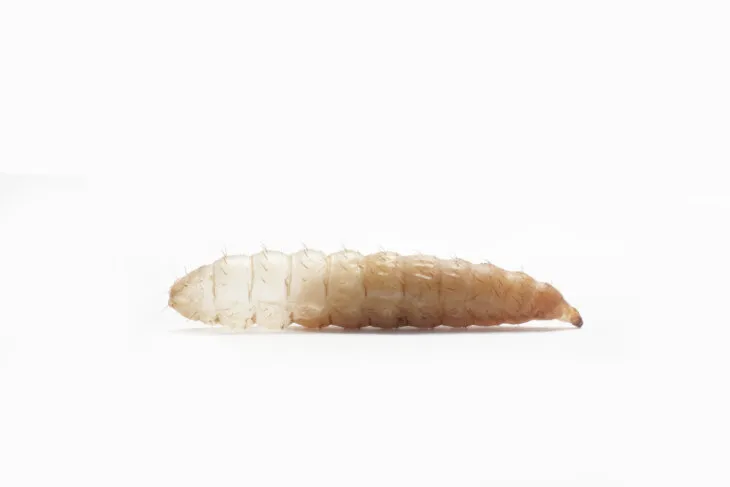
Nutritional Profile Of Black Soldier Fly Larvae
Black soldier fly larvae are higher in calcium than most other larval feeders and have a better calcium to phosphorus ratio. This will help prevent serious medical issues such as Metabolic Bone Disorder.
The nutritional profile of black soldier fly larvae:
| Nutrient | Content |
| Protein | 17.5% |
| Fat | 10-14% |
| Calcium | 9340 mg/kg |
| Phosphorous | 3560 mg/kg |
| Fiber | 3% |
| Moisture | 61.2% |
But, research shows that a lot of their promising calcium content is contained in their tough shells, which are not digestible.
Therefore, your Leopard Gecko will still benefit if you gut load and dust these feeders with vitamin and calcium powders.
The low fat content of black soldier fly larvae also contributes to their number-one spot on this list. They have less fat than both crickets and mealworms, making them an excellent staple feeder insect.
They won’t contribute to obesity and obesity-related diseases in your Leopard Gecko.
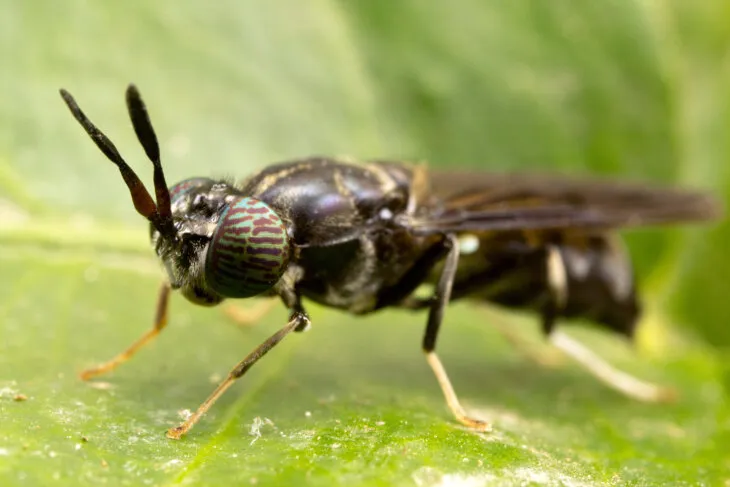
How Many Black Soldier Fly Larvae To Feed Your Leopard Gecko By Age
We’ve created a handy guide to help you portion up your black soldier fly larvae correctly. But remember, the sizes are just a guide.
Don’t feed large insects to smaller Leopard Geckos, as you could risk an impaction or choking.
| Age | Number of BSF Larvae |
| Young Leopard Geckos (0 to 4 months) | 4 to 10 BSF larvae (¼ inches) – per day |
| Juvenile Leopard Geckos (4 to 10 months) | 5 to 10 BSF larvae (½ inches) – 5 to 6 days a week |
| Mature Leopard Geckos (10 and more months) | 5 to 15 BSF larvae (¾ inches) – 2 to 3 times a week |
Risks Of Feeding Black Soldier Fly Larvae To Your Leopard Gecko
Black soldier fly larvae do not carry many risks for your Leopard Gecko. They don’t bite, so they can’t cause injury.
They don’t have a high fat content, so they don’t carry a great risk for causing obesity-related diseases.
Black soldier fly larvae come in a range of sizes. So, as long as you choose smaller-sized ones that are appropriate for your Leopard Gecko to swallow, there should be no great risk for impaction or choking, either.
How To Store Black Soldier Fly Larvae
Storing black soldier fly larvae can be challenging. They have a very short life cycle, so they will remain in the larval form for only around 5 days. Keeping them in the door of the fridge could slow down their development a little.
Therefore, it is important to keep them in a sealed container, so that you don’t unexpectedly have adult flies buzzing around. Also, don’t bulk-buy these feeders. You will need to feed out the whole container in 5-7 days.
To find out more about feeding black soldier fly larvae to your Leopard Gecko, check out our in-depth guide.
2. Silkworms (Bombyx mori)
Second place in our guide to the best worms for Leopard Geckos goes to silkworms! Silkworms are the larval stage of the silk moth. Silk moths have been domesticated for millennia, as we use them to create silk fabric.
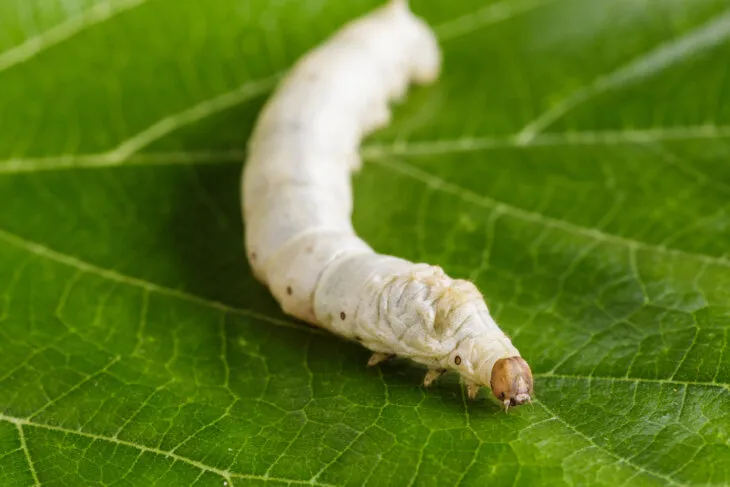
A fantastic benefit to buying silkworms for your Leopard Gecko is that if you keep them too long, they will turn into silk moths. Leopard Geckos can eat silk moths. Even some humans eat silk moths. They are a good source of protein and fats.

Nutritional Profile Of Silkworms
You might be surprised to learn that silkworms have a great nutritional profile for your Leopard Gecko. They are higher in protein and calcium and lower in fat than many other larval feeders.
| Insect Name | Silkworms (larvae) |
| Moisture % | 82.7 |
| Protein % | 9.3 |
| Fat % | 1.1 |
| Calcium Mg/Kg | 177 |
| Phosphorus Mg/Kg | 2370 |
Silkworms also produce an enzyme that has therapeutic properties, such as being anti-inflammatory and even promoting calcium absorption!
How Many Silkworms To Feed Your Leopard Gecko By Age
If you’d like to start feeding silkworms to your Leopard Gecko, consult this handy table to discover how many are appropriate to feed.
| Age | Number of Silkworms |
| Baby Leopard Geckos (0 to 6 months) | 5 to 10 silkworms (3/8 to 1/2 inch) – every day |
| Juvenile Leopard Geckos (6 to 10 months) | 6 to 10 silkworms (1/2 inch plus) – 4 to 5 times a week |
| Adult Leopard Geckos (10 months and beyond) | 6 to 12 silkworms (1 to 1 1/2 inches) – 2 to 3 times a week |
Risks Of Feeding Silkworms To Your Leopard Gecko
Silkworms do not pose much threat to your Leopard Gecko. They are slow-moving and soft. They don’t bite or sting. They are even easy to see and remove from the enclosure!
But, feeding silkworms to your Leopard Gecko does run a risk to your wallet. Silkworms are very expensive, and that’s why they have placed second on this list of top worms.
How To Store Silkworms
The way that you choose to store silkworms depends on whether you want them to stay smaller and worm-shaped, or whether you want them to grow into silkmoths.
If you want to prolong the larval stage, keep them in the door of the fridge. If you want them to turn into silk moths, feed them mulberry leaves and store them at room temperature.
You can learn more about feeding silkworms to your Leopard Gecko by reading our detailed guide.
3. Mealworms (Tenebrio molitor)
In third place on our list are mealworms. Mealworms are commonly fed as a staple part of Leopard Gecko’s diets, but many owners disagree over how suitable they are. Mealworms are the larval stage of a species of darkling beetle.
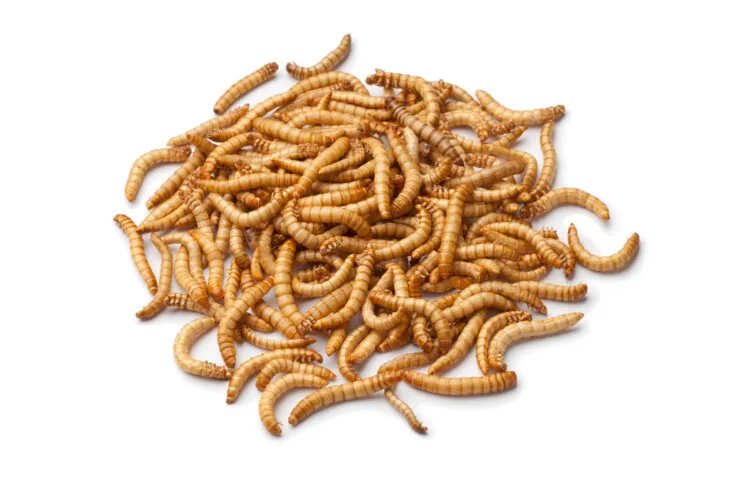
Nutritional Profile Of Mealworms
Mealworms have a fairly good nutritional profile, but their popularity is very varied among Leopard Gecko owners. Mealworms are high in protein, but also fairly high in fat and have a poor calcium to phosphorus ratio.
| Protein % | 20.72 |
| Fat % | 12.72 |
| Moisture % | 62.44 |
| Fiber % | 1.73 |
| Calcium/Phosphorus ratio % | 0.04 |
How Many Mealworms To Feed Your Leopard Gecko By Age
Here’s how many mealworms are ideal for you Leopard Gecko. Select mealworms in relation to the size of your Leopard Gecko.
Remember that the width between their eyes represents the width of their throat. In order to avoid choking or impaction, choose a worm that will fit easily down the throat.
| Age in months | How often feed | How much feed | |
| 0 – 6 | Baby | Daily | 5 – 7 small mealworms |
| 6 – 12 | Juvenile | Every other day | 5 – 7 small mealworms |
| > 12 | Adult | Every 3 – 4 days | 6 – 7 large mealworms |
Risks Of Feeding Mealworms To Your Leopard Gecko
There are some risks related to feeding mealworms to your Leopard Gecko. The first risk is that many Leopard Geckos owners feed their pets exclusively mealworms. This is not a good idea.
Leopard Geckos need to eat a range of feeder insects to receive the right nutrition. If you only give mealworms, your pet could end up suffering from Metabolic Bone Disease or obesity-related illnesses due to the less-than-ideal nutritional profile.
Many Leopard Gecko owners worry about the risk of impaction, due to the hard chitin shell mealworms have.
Fortunately, if you are choosing appropriately-sized worms, there is little risk of impaction due to the chitin (as we also explain here).
Again, though, the risk is reduced by feeding a varied diet.
Mealworms also do have jaws and are capable of biting your Leopard Geckos. While this is usually not a big issue, it does mean you ought to observe your Leopard Gecko while he eats mealworms, and remove any remaining from the
When your Leopard Gecko is asleep, he is more vulnerable to being nibbled by mealworms. These tiny injuries can get infected and cause illness.
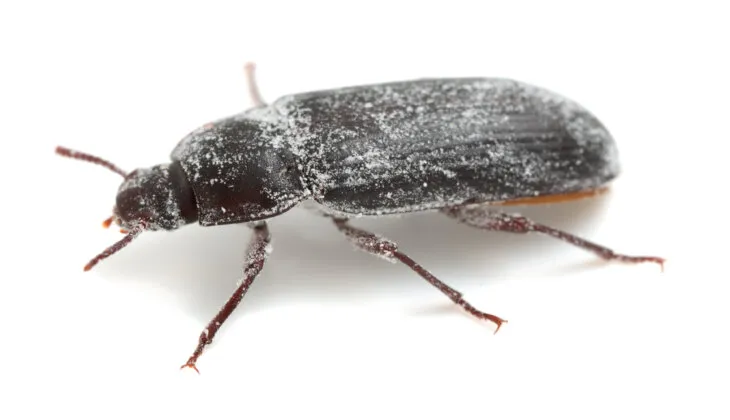
How To Store Mealworms
Mealworms are very hardy and easy to store. Simply keep them in the container they arrived in. They will do well and last longer if you keep them in the fridge door. They don’t particularly smell, and they have a long lifespan before turning into beetles.
As mealworms are used for many things, including as bird feed, exotic pet feed, and fishing bait, they are cheap and readily available. They even come in cans. But, we do not advise that you feed canned mealworms to your Leopard Gecko.
Mealworms also come in a freeze-dried form. We don’t recommend that you feed dried mealworms to your Leopard Gecko as a staple.
However, they can come in handy in an emergency. They are also much less squeamish for your non-reptile-loving friends to use when they come to care for your pet.
There’s still a lot to discover about feeding mealworms to your Leopard Gecko. If you want to find out more, please check out our feature article.
Giant Mealworms: Can You Feed Them To Leopard Geckos?
Mealworms are also available in giant-size. Giant mealworms are 5 times larger than normal mealworms. These are not the same thing as king worms or super worms, which are a different species.
You can feed giant mealworms to your Leopard Gecko. However, due to their massive size, they are not suitable for smaller, or juvenile, Leopard Geckos.
They carry an increased risk of impaction or injury through biting. Check our article on feeding giant mealworms to leopard geckos here if you plan to feed these to your gecko.
4. Buffalo Worms (Alphitobius Diaperinus)
Buffalo worms are great for small or juvenile Leopard Geckos. Buffalo worms are very small, being only 0.5-1cm long. They also have softer shells that are easier to digest.
Buffalo worms are the larval stage of a species of darkling beetle. Sometimes, buffalo worms and their darkling beetle stage are referred to as “lesser mealworms” and “lesser mealworm beetles”.
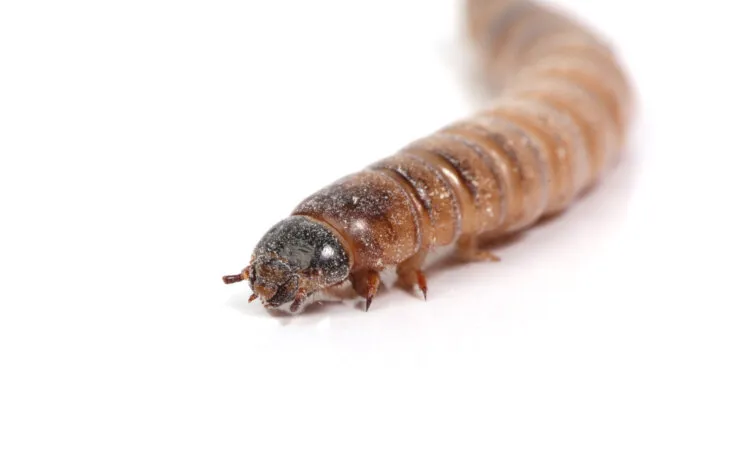
Nutritional Profile Of Buffalo Worms
The nutritional profile is also excellent for growing juveniles as the protein content is very high.
| Insect | Buffalo worm |
| Protein | 65% |
| Fat | 27.6% |
| Moisture | N/A |
| Fiber | 3.3% |
| Calcium/Phosphorus Ratio | N/A |
| Size (length) | 5.5mm- 1cm |
Risks Of Feeding Buffalo Worms To Your Leopard Gecko
The high fat content could cause obesity if buffalo worms are overfed consistently. Other than that, they don’t pose a lot of risks. They are ideally small and soft, and don’t bite.
How To Store Buffalo Worms
Buffalo worms need to be fed during storage with vegetables or specific insect
Simply keep them at room temperature and observe them to ensure they don’t turn into beetles. Don’t keep these worms in the fridge.
There’s a lot more to learn about how Leopard Geckos can eat buffalo worms. Visit our feature article to discover the best way to gut load and dust them.
5. Hornworms (Manduca quinquemaculata)
Fifth place on our top-worms list goes to hornworms. Hornworms are the larval stage, or caterpillar, of a hawkmoth. Hawkmoths are also called sphinx moths.
The scientific name of the hawkmoth family is Sphingidae and it contains more than 1500 different species.
The species commonly bred for consumption by Leopard Geckos is the tomato hawkmoth (Manduca quinquemaculata). The larval stage is the tomato hornworm (pictured). Sometimes, they are referred to as Goliath worms due to their large size.
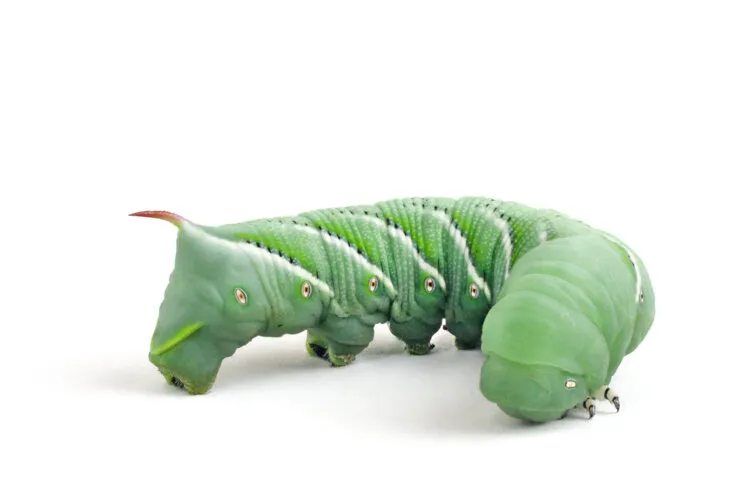
Nutritional Profile Of Hornworms
The best feature of hornworms is that they are very low in fat compared to some other delicious worms. This means that they are essentially a healthier treat that is less likely to contribute to obesity.
However, they do not contain much protein and their calcium to phosphorus ratio isn’t great. They do not make a great staple feeder insect.
| Nutrients | Value |
| Protein | 9% |
| Calcium | 464 mg/kg |
| Phosphorus | 1,394 mg/kg |
| Ca: P ratio | 1: 3 |
| Fat | 3% |
| Fiber | 1.2% |
| Moisture | 85% |
How Many Hornworms To Feed Your Leopard Gecko By Age
Hornworms should be fed as a sporadic treat as part of a regular, varied diet of staple feeder insects. Hornworms are large, and so are not ideal for small or young Leopard Geckos.
If you have some tiny hornworms, you can offer juvenile Leopard Geckos every couple of days. Juveniles should be eating their staple diet every day, to support their growth.
Adult Leopard Geckos can enjoy hornworms once every week or so. One large worm, or 2-3 smaller worms, would be an appropriate portion.
Risks Of Feeding Hornworms To Your Leopard Gecko
The primary risk of feeding hornworms to Leopard Geckos is their large size. They could easily cause choking or impaction. Be sure to select smaller worms for smaller Leopard Geckos.
Captive-born and bred hornworms will not be toxic, despite their bright colors that suggest they are. But, wild hornworms may feed upon vegetation that is toxic to your Leopard Gecko. Never feed wild hornworms to your Leopard Gecko.
Hornworms do not carry a great risk of causing obesity-related diseases. However, if you don’t dust them with calcium powder, they could contribute to MBD if fed too often.
How To Store Hornworms
Hornworms should arrive in a ventilated cup that contains hard
You can store the hornworms in a fridge at around 50 degrees Fahrenheit for a few days. This will slow down their development. However, don’t keep them cold for extended periods as they will die.
To discover more about how to prepare and feed hornworms to Leopard Geckos, check out our detailed guide.
6. Super worms (Zophobas morio)
Superworms slide into 6th place on our list of top worms for Leopard Geckos. Superworms are the larval stage of a large species of darkling beetle. They are also often referred to as king worms and morio worms.
Superworms look much like extremely big mealworms. They are around 5-6cm in size when they are nearing the end of the larval stage. Unlike mealworms, super worms have dark tails.
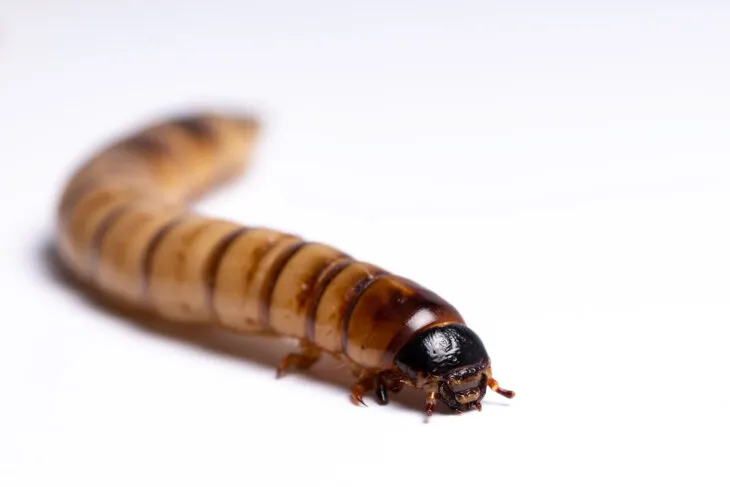
Nutritional Profile Of Superworms
Superworms have a similar protein content to mealworms. However, they are very high in fat and have a very poor calcium to phosphorus ratio. They aren’t an ideal staple feeder insect.
| Protein % | 20 |
| Fat % | 18 |
| Moisture % | 58 |
| Fiber % | 3 |
| Calcium/Phosphorus ratio % | 0.053 |
How Many Superworms To Feed Your Leopard Gecko By Age
Superworms’ large size makes them unsuitable for young Leopard Geckos. Superworms are best for underweight, adult Leopard Geckos. They are also useful as a treat to provide variation.
| Age in months | How often feed | How much feed | |
| 0 – 6 | Baby | Never or occasional treat. | Not suitable unless extremely tiny. Then give 2 or 3. |
| 6 – 12 | Juvenile | Never or occasional treat. | Not suitable unless very tiny. Then give 2 or 3. |
| > 12 | Adult | As a variation meal, every week or two. | 2 or 3 regular-sized mealworms. |
Risks Of Feeding Superworms To Your Leopard Gecko
Due to their very high phosphorus content, superworms present a risk of causing metabolic bone disorder if they are fed too often. The high fat content also makes them likely to contribute to obesity. Obesity is dangerous and leads to further diseases.
Due to their large size, they also pose a greater risk for causing impaction or choking. Their larger size also equals larger jaws, so there does pose a risk of biting at your Leopard Gecko if you leave them unattended.
How To Store Superworms
Superworms should be stored at room temperature, not in the fridge. Keep them in the container they come in, which should have tiny air holes in the top.
They need to be fed and bedded. You can use superworm bedding, or just a layer of oatmeal. Add slices of potato, as this works as a water source.
After the larval stage, superworms cocoon themselves in a pupa, as they transform. Check your superworms so that you can remove the pupae if you don’t want them to transform. Pupae are not toxic and can be eaten by large Leopard Geckos.
Finally, after exiting the pupa, the superworms will have finally transformed into a huge type of darkling beetle.
Your Leopard Gecko may be able to eat some types of darkling beetles. But, these ones are gigantic and we don’t recommend feeding them to Leopard Geckos.

If you’re still not sure if superworms are really okay for you Leopard Gecko, check our guide where we explore the topic further.
7. Wax Worms (Galleria mellonella)
Leopard Geckos absolutely love wax worms! But, they only get 7th palace on this list as they are a junk-food treat akin to candy.
Wax worms are the larval stage of the wax moth, otherwise known as the honeycomb moth. Wax worms are high in fat and calories and make excellent treats for Leopard Geckos.
They can also be used to build up underweight geckos or encourage their appetites.
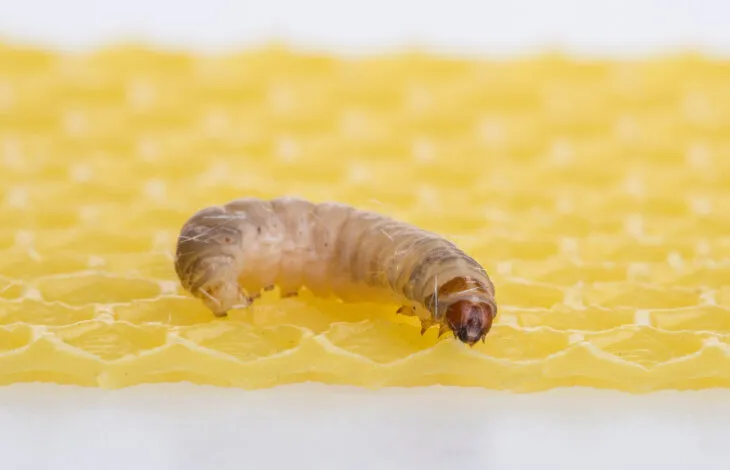
Nutritional Profile Of Wax Worms
Wax worms contain a fair but unimpressive amount of protein and moisture. But they are packed full of fat. They also have a fairly poor calcium to phosphorus ratio.
| Wax Worms | |
| Moisture | 62% |
| Protein | 14% |
| Fat | 18% |
| Fiber | 3% |
| Ca:P Ratio | 1:7 |
How Many Wax Worms To Feed Your Leopard Gecko By Age
Up until 4 months of age, baby Leopard Geckos should be eating daily. It is during this time that they are going to be introduced to a range of insects that will make up their staple diet for the rest of their lives.
If your young Leopard Gecko is accepting staple insects well, we do not recommend feeding wax worms at all, until they pass 1 year of age.
They run a risk of becoming addicted to this delicious
Beyond 1 year of age, we recommend giving wax worms to your Leopard Gecko as a sporadic treat. Change these treats out with others, and don’t deliver them in a pattern. At the very most, they could be offered wax worms once per week.
Offer 2 to 5 worms per treat day. Choose smaller worms for smaller Leopard Geckos, to reduce the risk of choking as well as to limit their portion size.
Risks Of Feeding Wax Worms To Your Leopard Gecko
Wax worms are fairly harmless, easily digestible, and certainly not toxic. The primary risk of feeding wax worms to your Leopard Gecko is their high fat level.
This can contribute to obesity, and dangerous obesity-related diseases.
How To Store Wax Worms
Wax worms are super easy to store and care for. They do not really need to be fed, and survive well in the door of the refrigerator. The cool temperature will slow down their development into moths.
Check them frequently and remove any cocoons that are in the process of being spun. This will help your wax worms last longer.
Wax Moths / Honeycomb Moths (Galleria mellonella)
Wax worms grow into wax moths. Did you know that Leopard Geckos can eat wax moths too? In fact, Leopard Geckos get great exercise and enrichment from hunting wax moths.
One of the great benefits of keeping wax worms is that there is no rush to feed them all. You can keep your wax worms and feed them to your Leopard Gecko as pupa, or as adult moths.
Check out our detailed guide to discover more about feeding wax worms to Leopard Geckos.
8. Butterworms (Chilecomadia moorei)
Finally, in 8th place on our top-worms list are butter worms. Butter worms are the larval stage of the life of the Chilean Moth.
Nutritional Profile Of Butterworms
Butter worms, as the name suggests, are very high in fat. They contain a fair amount of protein and moisture, similar to that of a wax worm. They can also cause some regurgitation, as they aren’t the easiest to digest.
| Insect | Butterworms |
| Moisture (%) | 60.2 |
| Fat (%) | 29.4 |
| Protein (%) | 15.5 |
| Ash (%) | 0.8 |
| Fiber (%) | 1.4 |
| Calcium (mg/kg) | 125 |
| Phosphorus (mg/kg) | 2250 |
| Thiamin (mg/kg) | 0.7 |
How Many Butterworms To Feed Your Leopard Gecko By Age
The advice for portioning butterworms is very similar to the advice for wax worms. Butterworms are full of fat and do not make good staple feeder insects.
We do not recommend that young or baby Leopard Geckos be given butterworms, as they could increase the risk of obesity, metabolic bone disorder, or an unhealthy preference for fatty treats during their developmental stage.
Adult Leopard Geckos could be offered 2 to 3 worms, a maximum of once per week. Try to change out your treats for variation and to prevent addiction.
Risks Of Feeding Butterworms To Your Leopard Gecko
There are a few risks related to feeding butterworms to your Leopard Gecko. The most prevalent is obesity and obesity-related disease. It is easy to overfeed butterworms due to their high fat content.
The second risk is that your Leopard Gecko may not digest this worm well. Butterworms have been known to get regurgitated.
Your Leopard Gecko may also simply not like the taste. Leopard Geckos are a bit more choosy about butterworms than they are about most other feeder insects. This could leave you out of pocket if you buy butterworms.
Butterworms could contribute to metabolic bone disorder if they are not properly dusted with calcium powder. They are almost impossible to gut load, thanks to the fact that they exclusively eat Trevo leaves.
Lastly, butterworms develop into Chilean moths. This species is invasive and harmful to the environment outside of South America. This means they are a tightly-controlled invasive species. Sometimes, this can make them hard to get hold of.
How To Store Butterworms
Butterworms are simple to store. Simply keep them enclosed in the container that they arrive in. There is no need to feed them, as they only eat Trevo leaves.
Butterworms should be irradiated to prevent them from pupating. This prevents the invasive species from reproducing and escaping into the environment.
If you do for any reason see butterworms transforming, the responsible thing to do is to kill them.
Learn more about feeding butterworms to Leopard Geckos in our in-depth article.
Worms That Leopard Geckos Can’t Eat
There are hundreds of types of worms out there, and some of them could be harmful to your Leopard Gecko.
Armyworms (Spodoptera frugiperda +etc.)
The term armyworm can refer to a number of different species of moth larvae. Armyworms are highly destructive of crops and invasive across many parts of the globe.
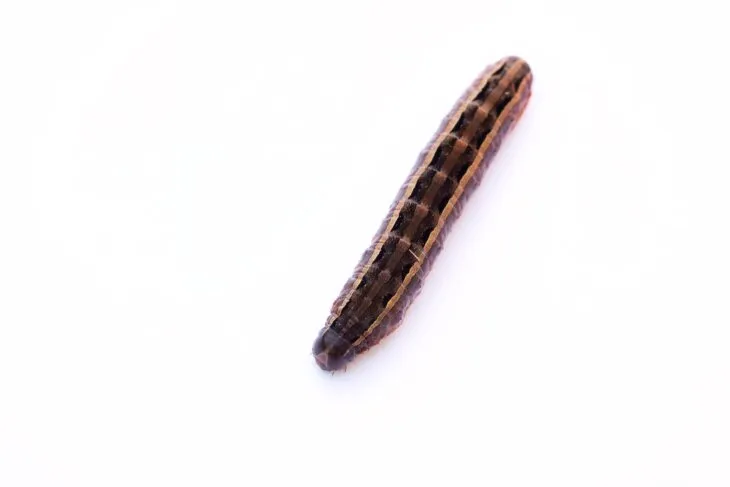
Armyworms, in themselves, are not harmful to Leopard Geckos. But, Armyworms are not readily available to buy as food for Leopard Geckos. It is imperative that you do not capture and feed wild armyworms to your Leopard Gecko.
The destructive and invasive nature of armyworms means that they will likely have been exposed to insecticides and pesticides in an effort to control their population. These are toxic to your Leopard Gecko.
Inchworms (Geometridae spp.)
Inchworm is a common name for hundreds of different species of moth in their larval stage. The adult Geometer moths are often cited as pests, laying their eggs on crops.
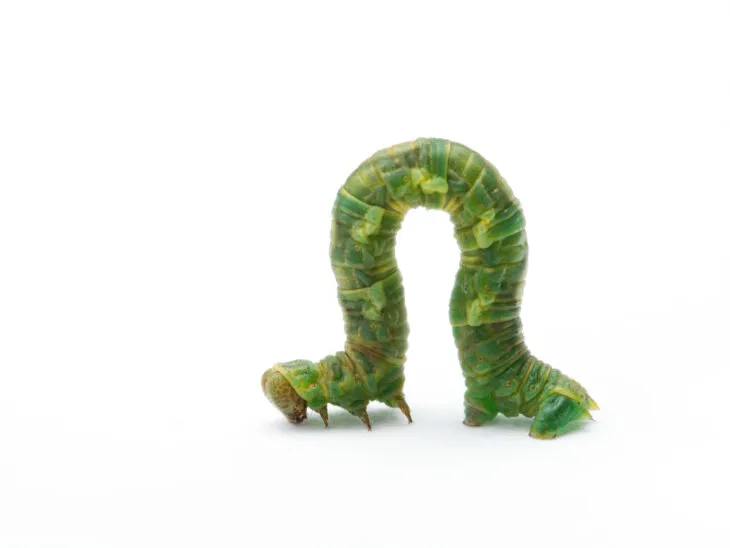
Inchworms in themselves are not toxic to Leopard Geckos, and your pet probably could eat them without issue.
However, inchworms are not readily bred and available to buy as feeder insects. It is very important that you do not capture wild inchworms and feed them to your geckos.
Due to the role of the inchworm as a pest, people often treat their
As such, you should not feed inchworms to your Leopard Gecko.
Redworms (Eisenia fetida)
Red worms are different to all the other worms mentioned in this article as they are not larvae. Redworms are a species of earthworm.
They are very common on the European continent. Red worms are not the larval stage of another type of insect. They live and reproduce in the form of a worm.
Red worms have good nutritional value. However, earthworms in general secrete an unpleasant substance that your Leopard Gecko will not like the taste of.
While leos can eat these worms, we still recommend feeding other worms. Find out more in our article about whether Leopard Geckos can eat earthworms.
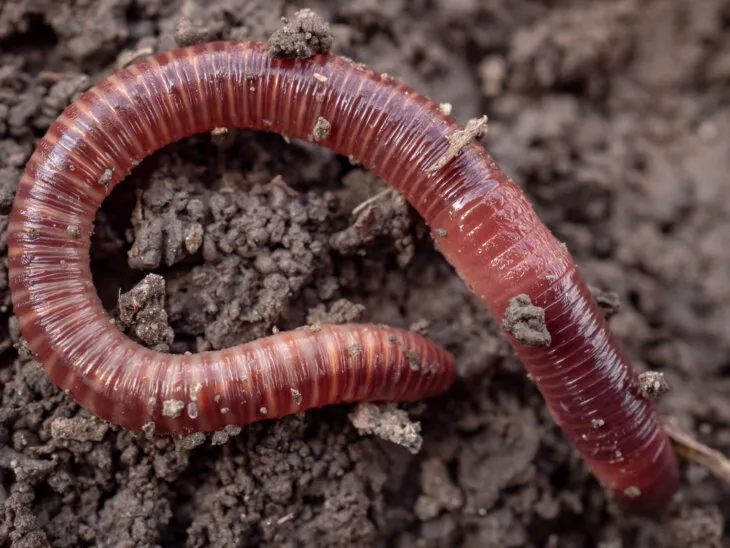
Can Leopard Geckos Eat Worms From Outside?
Leopard Geckos should not eat wild worms or any other insect from outside. Worms from outside have been exposed to pathogens such as bacteria, viruses, and parasites that they could pass on to your Leopard Gecko.
Worms from outside may also have been exposed to chemicals used by humans. These include pesticides, insecticides, and fertilizers. All of these chemicals are very dangerous and could kill your Leopard Gecko if ingested.
Can Leopard Geckos Eat Dead Worms?
Leopard Geckos should not eat dead worms, or any other dead animals. In some cases, you may know what the worms died from, but not in all cases.
The worm could have died from disease or infection, which it could then pass on to your Leopard Gecko. The worm could have died of poisoning from chemicals, which would still be contained within its body.
Even if the worm died of dehydration or old age, it still poses a threat. As soon as an animal dies, bacteria and fungi move in and begin to alter the body.
Eating a dead worm could cause your Leopard Gecko to ingest harmful microbes.
Where Can You Buy Worms For Your Leopard Gecko?
There are many reputable and professional breeders of worms around the world. It is best to buy from a breeder that:
- Is as close to you as possible.
- Has a fantastic reputation.
Choosing a breeder close to you will reduce the travel time of your worms. It may also prevent them from being exposed to damaging conditions such as extreme temperatures in transit, or from being shaken about.
It is worth paying more for a worm breeder and supplier with a great reputation. The methods that they use to house, feed, and transport the worms will have a direct effect on the health of your Leopard Gecko.
So, it isn’t possible for us to give one recommendation for the best place to buy your worms. The best suppliers will be different for everyone. But here are some well-reputed stores in the USA to get you started.
Josh’s Frogs worms have glowing reviews and offer a live arrival guarantee on all feeder insects. Reviewers were satisfied with the plumpness of the worms and how much they wriggled.
Josh’s Frogs are based in Owosso, Michigan. They ship orders that are placed by 12.00 pm EST the same day.
Rainbow Mealworms specialize in mealworms but have excellent reviews for their other worms too. Repeat customers say that their mealworms always arrive more alive and feisty than any previous retailers they have tried.
Rainbow Mealworms are based in Compton, California. They do have walk-in hours and you can collect online orders by scheduling a pick-up. Orders made before 12:00 pm PST are shipped the same day. There are many shipping options.
DubiaRoaches.com are based in Wichita, Kansas. They have hundreds of excellent reviews, that claim the worms always arrive fat and healthy.
DubiaRoaches.com offer next-day shipping. They also have an insurance add-on option to cover damaged or dead wax worms.
- Enchi Ball Python: A Unique and Stunning Morph of Python regius - March 27, 2025
- Emerald Tree Monitor: The Enigmatic Green Guardian of the Rainforest - March 26, 2025
- The Egyptian Cobra (Naja haje): A Fascinating Serpent - March 25, 2025
